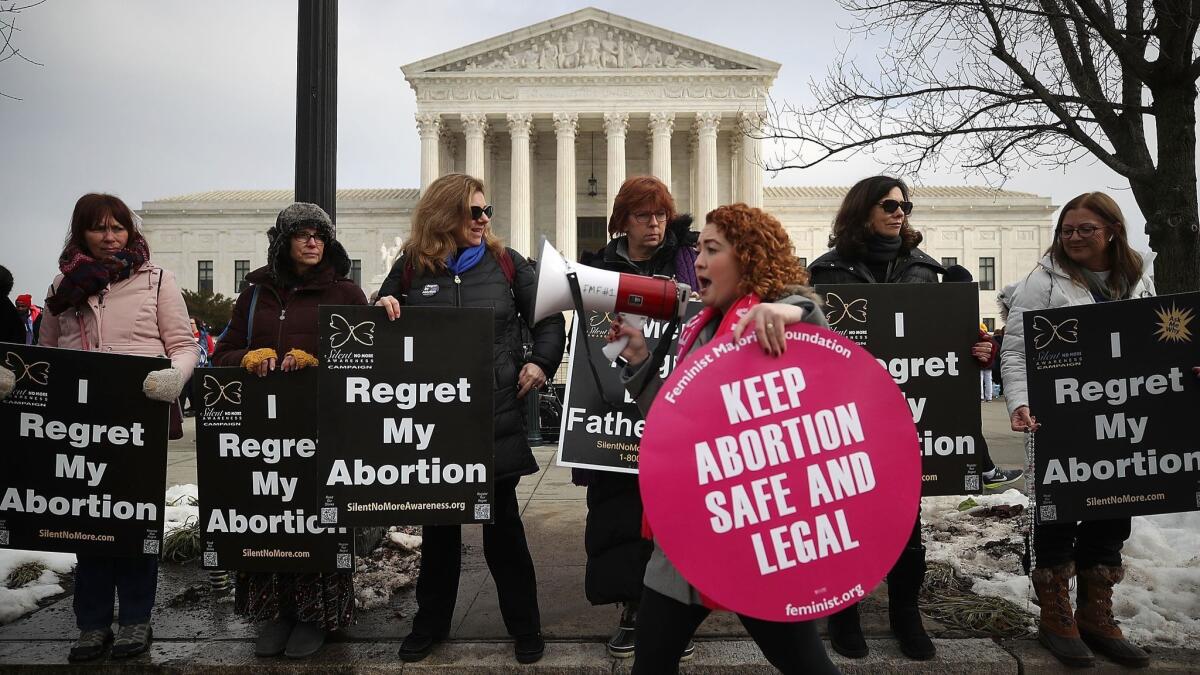Column: There’s a middle ground on abortion. Really

- Share via
“Democrats are aggressively pushing late-term abortion allowing children to be ripped from their mother’s womb right up until the moment of birth,” President Trump told a Florida rally last week. “The baby is born and you wrap the baby beautifully and you talk to the mother about the possible execution of the baby.”
For cable news talking heads and leading Democrats, this is a demagogic lie. The fact-checkers mostly say it’s a distortion and exaggeration — and it is. It’s a distortion of something Virginia Gov. Ralph Northam said, days before revelations he dressed in black face — or in a Klan outfit — during medical school eclipsed the controversy.
Trump has been referencing Northam’s remarks since January, when Kathy Tran, a Democratic Virginia delegate introduced legislation to liberalize abortion in her state. During a colloquy with a Republican lawmaker, Tran said her bill would legalize abortions through the 40th week of pregnancy, including during labor (she later said she misspoke when it was pointed out that violated infanticide laws).
Roe created this polarized — and polarizing — dynamic, in which the debate is dominated by the extremes.
The next day Northam — a pediatric neurologist by training — appeared on a local radio station to support Tran and her bill. He also explained how, in cases where a fetus was not viable, “the infant would be delivered, the infant would be kept comfortable, the infant would be resuscitated if this is what the mother and the family desired, and then a discussion would ensue between the physician and the mother.”
Now, Northam never said anything about “executing” babies. But Tran’s legislation would have allowed late-term abortions of viable, non-deformed, babies solely if the mother’s mental or emotional health was threatened.
Her bill didn’t pass, but that same month, Democratic New York Gov. Andrew Cuomo signed similar legislation.
All of this is worth keeping in mind amid the furor over Alabama’s near-total abortion ban. If we go by the attitudes of the American people, both laws are extreme. Polling on abortion is notoriously fraught. Wording matters enormously because many Americans themselves are conflicted on the issue. But generally, most Americans support early-stage abortions and opposition grows along with the fetus. According to Gallup, 60% of Americans support abortion rights in the first trimester, but only 13% do in the third.
The media’s double standard in how it treats laws like New York’s and Alabama’s speaks volumes about their attitudes on the topic. But it also speaks to the legal and political landscape. Even Ruth Bader Ginsburg, a strong defender of abortion rights, has called the Supreme Court’s 1973 Roe vs. Wade decision a “heavy-handed judicial intervention,” and said she would have preferred that abortion rights were secured more gradually with greater buy-in at the state level.
Under Roe (and later Planned Parenthood vs. Casey), the court not only imposed one of the most permissive abortion regimes in the world, it foreclosed state-level compromise, galvanizing the pro-life movement and causing both pro-choicers and pro-lifers to take more absolutist positions.
Alabama’s law is clearly unconstitutional under current precedent. But that’s the point. Alabama’s GOP legislators deliberately passed an unconstitutional law in the hope that the court’s new conservative majority would overthrow Roe and Casey. New York’s Democratic lawmakers weren’t trying to test Roe or Casey, but create a post-Roe abortion “sanctuary” in case Alabama’s gamble is correct.
Enter the Fray: First takes on the news of the minute »
As a practical matter, Roe made it necessary for the pro-life movement to embrace an incremental strategy, working to change attitudes, chip away at Roe at the margins and work to reduce the abortion rate (with considerable success). But now that some think the brass ring is in sight, the movement has split between incrementalists and those — like the sponsors of the Alabama bill — who think it’s worth going for broke (I think they’re wrong).
The underlying political reality is that most Americans want a compromise, but the parties are more responsive to the activists and donors. As a result, Democrats have abandoned their “safe, legal and rare” rhetoric while Republicans are downplaying a “culture of life.” Instead each seeks to cast the other party as extreme. Republicans highlight rare late-term abortions and Democrats focus on the also rare cases of 12-year-olds impregnated by their rapist fathers.
Roe created this polarized — and polarizing — dynamic, in which the debate is dominated by the extremes. Overturning it and allowing states to pass laws that reflect majority opinion might not defuse the political passion. But at some point we are likely to find out.
jgoldberg@latimescolumnists.com
More to Read
A cure for the common opinion
Get thought-provoking perspectives with our weekly newsletter.
You may occasionally receive promotional content from the Los Angeles Times.










